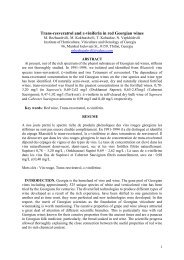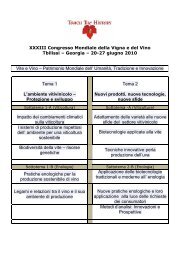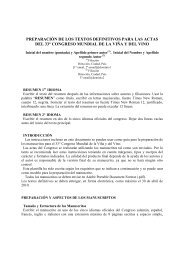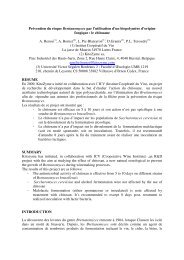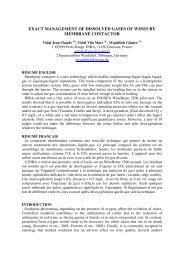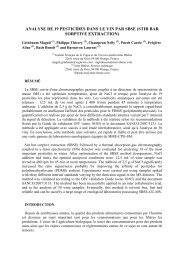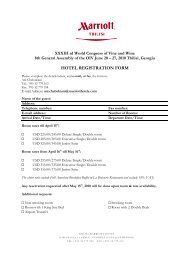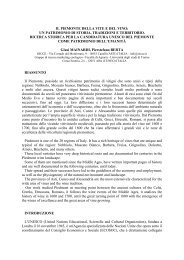Characterization of Georgian white grape wines made ... - Oiv2010.ge
Characterization of Georgian white grape wines made ... - Oiv2010.ge
Characterization of Georgian white grape wines made ... - Oiv2010.ge
You also want an ePaper? Increase the reach of your titles
YUMPU automatically turns print PDFs into web optimized ePapers that Google loves.
stem contact and all <strong>wines</strong> – without. Rkatsiteli from Kardenakhi fermented and aged with<br />
stem contact, had less purity and less brightness than <strong>wines</strong> vinified without stems.<br />
Names<br />
Table 1 General composition <strong>of</strong> amphorae <strong>wines</strong><br />
alcohol<br />
(% v/v)<br />
tot.<br />
acidity<br />
(gL -1<br />
tartaric<br />
acid)<br />
volatile<br />
acidity<br />
(gL -1<br />
acetic<br />
acid)<br />
pH purity brightness<br />
Dom.<br />
wave<br />
length<br />
Kakhuri Mtsvane 12,7 5,1 0,48 3,47 16,02 91,22 575,85<br />
Rkatsiteli Kardenakhi 11,9 5,2 0,44 3,49 12,29 92,86 576,07<br />
Rkatsiteli Gurjaani 12,6 5,7 0,41 3,22 13,15 92,43 576,22<br />
Rkatsiteli Kardenakhi with stems 11,8 5,0 0,54 3,45 6,67 85,75 577,19<br />
The amounts <strong>of</strong> volatile compounds determined by gas-chromatography in Rkatsiteli and<br />
Mtsvane <strong>grape</strong> <strong>wines</strong> are presented in Tab. 2.<br />
The reported metabolites, even if they were expression <strong>of</strong> a particular vinification process,<br />
did not let a punctual analysis about their origin because <strong>of</strong> the unknown development <strong>of</strong><br />
micr<strong>of</strong>lora during fermentation.<br />
Higher alcohols and esters, produced during alcoholic fermentation, play an important role<br />
in the flavour <strong>of</strong> the <strong>wines</strong>, depending on the types <strong>of</strong> compounds and their concentrations<br />
(Valero et al. 2002). The most plentiful compounds were the higher alcohols, in agreement<br />
with the literature (Baumes et al. 1986). At concentrations below 300 mgL -1 they certainly<br />
contribute to the desirable complexity <strong>of</strong> wine; when their concentrations exceed 400 mgL -1 ,<br />
higher alcohols are regarded as a negative quality factor (Mateo et al. 2001). The total<br />
concentration <strong>of</strong> higher alcohols in experimental <strong>wines</strong> was below 300 mgL -1 .<br />
It can be mentioned, that there was not any difference among <strong>wines</strong>, except <strong>of</strong> isoamyl<br />
alcohol content, which was higher in stem contact wine. Also this last wine characterized with<br />
highest amount <strong>of</strong> 1-hexanol, which indicated that extended the pomace and especially the<br />
stem contact time can raise the formation <strong>of</strong> this compound, which agrees with results<br />
obtained by other authors (Cordonnier and Bayonove 1979, Rankine and Pocock 1969). It is<br />
significant, that there was notable difference between stem and non-stem contact <strong>wines</strong> in the<br />
content <strong>of</strong> ethyl lactate, ethyl 3-OH-butyrate, ethyl 4-OH-butyrate and monoethylsuccinate,<br />
which were much higher in first one. Wine <strong>made</strong> by Kakhuri Mtsvane <strong>grape</strong> variety was<br />
distinguished with higher concentration <strong>of</strong> 2-phenyl ethanol, 2-phenyl ethyl acetate.<br />
4



